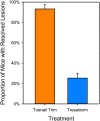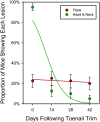A "Pedi" Cures All: Toenail Trimming and the Treatment of Ulcerative Dermatitis in Mice
- PMID: 26735497
- PMCID: PMC4703297
- DOI: 10.1371/journal.pone.0144871
A "Pedi" Cures All: Toenail Trimming and the Treatment of Ulcerative Dermatitis in Mice
Abstract
Ulcerative Dermatitis (UD) is the most common cause of unplanned euthanasia in mice used in research, with prevalence rates reported between 4 and 21%. UD is characterized by a deep, ulcerative lesion that appears most commonly over the dorsal neck and is attendant with an intense pruritus. The underlying cause of UD is currently unknown, and as a consequence, there are no directed therapies that resolve lesions reliably. However, there is a growing body of evidence that suggests a behavioral component to the onset, maintenance, and progression of UD lesions. Scratching behavior in response to the intense pruritus associated with UD lesions may be an effective target for interventional therapies. We hypothesized that interfering with scratching behavior by trimming the toenails of mice with UD, would resolve UD lesions. To test this hypothesis, we first evaluated the efficacy of toenail trims with a single application of Vetericyn at the time of treatment versus our previous standard of care, topical Tresaderm applied daily. We found that toenail trims were significantly more effective at resolving lesions (n = 39 toenail trims, n = 100 Tresaderm, p<0.0001) with 93.3% of animals healing by 14 days (median time to lesion resolution). Furthermore, dorsal neck lesions did not recur by 42 days after a single toenail trim (n = 54); however, flank lesions did not resolve and the outcome of the two lesion distributions following treatment were significantly different (p<0.0001). Finally, we implemented toenail trims at an institutional level and found similar efficacies (approximately 90%) for toenail trims regardless of one-time topical supplement used (triple antibiotic ointment, Tresaderm, and Vetericyn, n = 55, 58, 18, p = 0.63). This is the first report of a highly effective treatment for one of the most serious welfare issues in laboratory mice.
Conflict of interest statement
Figures






Similar articles
-
Retrospective Evaluation of Nail Trimming as a Conservative Treatment for Ulcerative Dermatitis in Laboratory Mice.J Am Assoc Lab Anim Sci. 2016;55(4):462-6. J Am Assoc Lab Anim Sci. 2016. PMID: 27423154 Free PMC article.
-
Evaluation of topical oclacitinib and nail trimming as a treatment for murine ulcerative dermatitis in laboratory mice.PLoS One. 2022 Oct 18;17(10):e0276333. doi: 10.1371/journal.pone.0276333. eCollection 2022. PLoS One. 2022. PMID: 36256616 Free PMC article.
-
Ulcerative Dermatitis in C57BL/6NCrl Mice on a Low-Fat or High-Fat Diet With or Without a Mineralized Red-Algae Supplement.J Am Assoc Lab Anim Sci. 2015 Sep;54(5):487-96. J Am Assoc Lab Anim Sci. 2015. PMID: 26424246 Free PMC article.
-
Comparison of 3 Topical Treatments against Ulcerative Dermatitis in Mice with a C57BL/6 Background.Comp Med. 2016 Apr;66(2):100-4. Comp Med. 2016. PMID: 27053563 Free PMC article.
-
[Claw health in Dutch dairy herds, an update of some recent disorders].Tijdschr Diergeneeskd. 2009 Mar 1;134(5):200-5. Tijdschr Diergeneeskd. 2009. PMID: 19331066 Review. Dutch.
Cited by
-
Evaluation of Treatment Options for Ulcerative Dermatitis in the P Rat.J Am Assoc Lab Anim Sci. 2021 May 1;60(3):311-318. doi: 10.30802/AALAS-JAALAS-20-000058. Epub 2021 May 3. J Am Assoc Lab Anim Sci. 2021. PMID: 33952383 Free PMC article.
-
Elevated Arsenic and Lead Concentrations in Natural Healing Clay Applied Topically as a Treatment for Ulcerative Dermatitis in Mice.J Am Assoc Lab Anim Sci. 2020 Mar 1;59(2):212-220. doi: 10.30802/AALAS-JAALAS-19-000068. Epub 2020 Feb 14. J Am Assoc Lab Anim Sci. 2020. PMID: 32059757 Free PMC article.
-
The epidemiology of fighting in group-housed laboratory mice.Sci Rep. 2020 Oct 6;10(1):16649. doi: 10.1038/s41598-020-73620-0. Sci Rep. 2020. PMID: 33024186 Free PMC article.
-
Predictive Value of Grooming Behavior for Development of Dermatitis in Selectively Bred P Rats as a Model of Trichotillomania Hair Pulling Disorder.Vet Sci. 2022 Feb 18;9(2):89. doi: 10.3390/vetsci9020089. Vet Sci. 2022. PMID: 35202342 Free PMC article.
-
Introducing Therioepistemology: the study of how knowledge is gained from animal research.Lab Anim (NY). 2017 Mar 22;46(4):103-113. doi: 10.1038/laban.1224. Lab Anim (NY). 2017. PMID: 28328885 Review.
References
-
- Andrews AG, Dysko RC, Spilman SC, Kunkel RG, Brammer DW, Johnson KJ. Immune complex vasculitis with secondary ulcerative dermatitis in aged C57BL/6NNia mice. Veterinary pathology. 1994;31(3):293–300. . - PubMed
-
- Kastenmayer RJ, Fain MA, Perdue KA. A retrospective study of idiopathic ulcerative dermatitis in mice with a C57BL/6 background. Journal of the American Association for Laboratory Animal Science: JAALAS. 2006;45(6):8–12. . - PubMed
-
- Hampton AL, Hish GA, Aslam MN, Rothman ED, Bergin IL, Patterson KA, et al. Progression of ulcerative dermatitis lesions in C57BL/6Crl mice and the development of a scoring system for dermatitis lesions. Journal of the American Association for Laboratory Animal Science: JAALAS. 2012;51(5):586–93. - PMC - PubMed
-
- Blackwell BN, Bucci TJ, Hart RW, Turturro A. Longevity, body weight, and neoplasia in ad libitum-fed and diet-restricted C57BL6 mice fed NIH-31 open formula diet. Toxicologic pathology. 1995;23(5):570–82. . - PubMed
Publication types
MeSH terms
Grants and funding
LinkOut - more resources
Full Text Sources
Other Literature Sources

